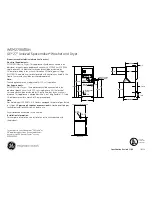
15
Pressure washer parts should be kept clean to reduce the
risk of overheating and ignition of accumulated debris.
• Use a damp cloth to wipe exterior surfaces clean.
• Use a soft bristle brush to loosen caked on dirt, oil,
etc.
• Use a vacuum cleaner to pick up loose dirt and debris.
• Use low pressure air (not to exceed 25 psi) to blow
away dirt. Inspect cooling air slots and openings on
the pressure washer. These openings must be kept
clean and unobstructed.
Check and Clean Inlet Screen
Examine garden hose inlet screen. Clean if it is
clogged or replace if it is torn.
Check High Pressure Hose
High pressure hoses can develop leaks from wear,
kinking, or abuse. Inspect hose before each use.
Check for cuts, leaks, abrasions, bulging of cover, or
damage or movement of couplings. If any of these
conditions exist, replace hose immediately.
Check Gun and Nozzle Extension
Examine hose connection to gun and make sure it is
secure. Test trigger by pressing it and making sure it
springs back into place when you release it. Engage
safety latch and test trigger. You should not be able to
press trigger. Replace gun immediately if it fails any of
these tests.
Check In-Line Filter
Refer to the illustration and service the in-line filter if it
becomes clogged, as follows:
1. Detach nozzle extension from gun and remove
o-ring and screen from nozzle extension. Flush
screen, gun, and nozzle extension with clean water
to clear debris.
2. Place in-line filter screen into threaded end of
nozzle extension. Direction does not matter. Push
screen in with eraser end of pencil until it rests flat
at bottom of opening. Take care not to bend
screen.
3. Place o-ring into recess. Push o-ring snugly against
in-line filter screen.
4. Assemble nozzle extension to spray gun, as
described earlier in manual.
Nozzle Maintenance
A pulsing sensation felt while squeezing the spray gun
trigger may be caused by excessive pump pressure.
The principal cause of excessive pump pressure is a
nozzle clogged or restricted with foreign materials,
such as dirt, etc. To correct the problem, immediately
clean the nozzle following these instructions:
1. Shut off engine and turn off water supply.
2. Remove nozzle from end of nozzle extension.
Separate nozzle extension from spray gun. Twist
nozzle clockwise to stream position. Using a 2mm
(5/64) allen wrench, remove orifice from end of
nozzle extension.
3. Remove in-line filter from other end of nozzle
extension.
4. Use a small paper clip to free any foreign material
clogging or restricting orifice.
5. Using a garden hose, remove additional debris by
back flushing water through nozzle extension. Back
flush between 30 to 60 seconds. Turn adjustable
nozzle extension to stream spray and move nozzle
from low to high while flushing.
6. Reinstall orifice and in-line filter into nozzle
extension. DO NOT overtighten orifice with allen
wrench.
7. Reconnect nozzle extension to spray gun.
8. Reconnect water supply, turn on water, and start
engine.
9. Test pressure washer by operating nozzle in high
and low positions.
Nozzle extension
In-line Filter
O-ring
Insert wire into orifice and turn back
and forth to clear obstruction.
• NEVER repair high pressure hose. Replace it.
• Replacement hose rating MUST exceed maximum
pressure rating of unit.
The high pressure stream of water that this
equipment produces can pierce skin and its
underlying tissues, leading to serious injury
and possible amputation.
WARNING
• DO NOT insert any objects through cooling slots.
Improper treatment of pressure washer can
damage it and shorten its life.
CAUTION
















































